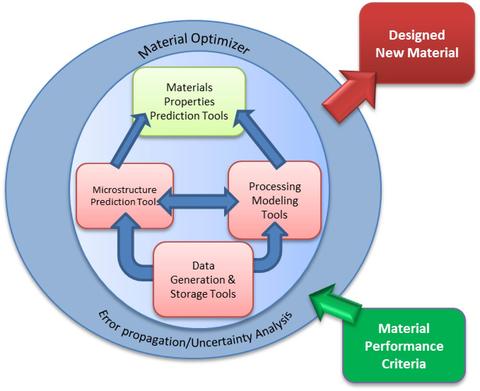Summary
The Materials Genome Initiative will create a new era of materials innovation that will serve as a foundation for strengthening domestic industries in these fields. This initiative offers a unique opportunity for the United States to discover, develop, manufacture, and deploy advanced materials at least twice as fast as possible today, at a fraction of the cost. Essential to this effort is the development of a data infrastructure that will provide the needed data and tools to support this effort. Some of the fundamental data needed for this infrastructure is phase based material data.
Phase-based data includes thermodynamics, diffusion, molar volume, elastic properties, electrical conductivity, thermal conductivity and may be extended to two phase descriptions such as interfacial energies. Phase-based data includes both experimental and computational data. One of the biggest challenges is addressing the multicomponent nature of phase-based data. Another challenge is that the different users of the data have different needs. For example, an industrial user user may just want a number (i.e. the diffusion coefficient for specific material). While an expert in the field may want all the available raw data (i.e. expert in diffusion may want not only the report diffusion coefficients and reported composition profiles, but also the SIMS intensity vs distance data (if SIMS was used to collect the diffusion data.) This requires that data infrastructure be built to accommodate a variety of user needs and as well as data types.
Description

To develop the need data infrastructure and informatics tools, NIST is focusing on three areas: data curation, data infrastructure, and data access.
- Data curation efforts include efforts to develop a phase-based materials ontology to ensure that the data is represented in a semantically consistent fashion by disparate members of the phase-based data community and will facilitate search, transformation and reasoning with the curated data. Domain level modeling using UML (Unified Modeling Language) will enable software development that is consistent with develop ontologies and data schemas. XML schema will also be developed for different phase-based use cases. A variety of existing XML schemas will be incorporated and/or expanded, including the ThermML schema. The curated data will be encoded in a consistent and repeatable fashion with the necessary provenance and will be properly stored in the appropriate repositories. Web-based interfaces will be used to capture curated data.
- The database infrastructure will be structured to manage the large amount of heterogeneous data in flexible way and capable of supporting complex data queries. This infrastructure will be distributed, federated, and heterogeneous and will draw from modern NoSQL databases as well as more traditional relational technologies.
- Data access to this heterogeneous, federated database systems capable of handling complex dynamic queries will require the development of programmable access to the data via traditional APIs, Web APIs (REST), and data exchange facilities and formats (XML, JSON, BSON). These interfaces and facilities will serve as the foundation for flexibility and scalability. These interfaces will enable data analytics and machining learning tools.

Major Accomplishments
- File repositories for CALPHAD and first principles calculations have been established using a DSpace platform. ( materialsdata.nist.gov)
- Phase-Based Data Repository (includes multicomponent phase data with a focus on phase transition temperatures and interdiffusion and tracer diffusivity data)
- Hosted NIST/CHiMaD CALPHAD Data Workshop to determine data needs for CALPHAD assessments.
- XML schemas tracer and interdiffusion data have been proposed.
Data Informatics and Tools for Phase-Based Property Data presentation from 2nd World Congress on ICME, Salt Lake City, July 9, 2013.

